Abstract
In this paper, the unconditional superconvergence error analysis of the semi-implicit Euler scheme with low-order conforming mixed finite element discretization is investigated for time-dependent Navier–Stokes equations. In terms of the high-accuracy error estimates of the low-order finite element pair on the rectangular mesh and the unconditional boundedness of the numerical solution in -norm, the superclose error estimates for velocity in -norm and pressure in -norm are derived firstly by dealing with the trilinear term carefully and skillfully. Then, the global superconvergence results are obtained with the aid of the interpolation post-processing technique. Finally, some numerical experiments are carried out to support the theoretical findings.
Keywords:
Navier–Stokes equations; linearized Euler scheme; low-order conforming MFEM; superconvergence error estimates MSC:
65N06; 65N55
1. Introduction
In this paper, we consider the following two-dimensional time-dependent incompressible Navier–Stokes equations:
where is a rectangular domain with boundary , represents the velocity vector, denotes the pressure, and is the prescribed body force, . Moreover, is the initial velocity and is the final time.
Navier–Stokes equations are a classical incompressible fluid model and have been widely applied in the mathematical physics and the computational fluid dynamics fields [1,2,3]. It is an unrealistic thing to find the the exact solutions of the Navier–Stokes equations due to their nonlinear and incompressible properties. Therefore, numerous works have been devoted to the development of efficient numerical approximations for Navier–Stokes Equations (1)–(4), including finite difference methods [4,5,6,7], Galerkin finite element methods [8,9,10,11,12,13,14,15,16,17,18,19,20,21] and other methods [22,23,24,25,26]. In particular, a new second-order accurate finite difference scheme for the incompressible Navier–Stokes equations was discussed in [4] by the primitive variable formulation. Based on the vorticity stream-function formulation and a fast Poisson solver defined on a general domain using the immersed interface method, a fast finite difference method was proposed and studied in [5] for the incompressible Navier–Stokes equations. A new fully discrete finite element nonlinear Galerkin method was established in [8] for the Navier–Stokes equations with two-grid finite element discretization in the spatial direction and Euler explicit scheme with variable time step size in the temporal direction. The boundedness, convergence and stability condition of the presented method were discussed under certain time-step constraints dependent on the coarse grid parameter. A Lagrange–Galerkin mixed finite element approximation was presented for the Navier–Stokes equations in [13], and optimal error estimates were obtained with the mesh restriction , where , and , h and d denote the time step size, the mesh size and the dimension of the domain, respectively. In [14], in terms of the special properties of a low-order nonconforming mixed finite element pair on the rectangular mesh, the superconvergence error estimates were derived for Navier–Stokes equations with the time-step constraints , due to the inverse inequality used in the error analysis. In [18], in terms of the error splitting technique developed in [27,28], the unconditional stability and convergence of a typical modified characteristics finite element method were studied for the time-dependent Navier–Stokes equations by introducing an iterated characteristic time-discrete system. Optimal error estimates were obtained under the boundedness of the numerical solution in -norm. Subsequently, the unconditionally optimal error estimates were derived in [20] under the boundedness of the numerical solution in -norm, which is weaker than that in [18].
It should be pointed out that optimal error estimates were obtained in [20] due to roughly handling trilinear terms. Moreover, the superconvergence error estimates were derived in [14] with a certain time-step restriction. To the best of our knowledge, there are few contributions on the unconditionally superclose and superconvergence error estimates for problems (1)–(4). The purpose of this paper is to consider the unconditionally superclose and superconvergence error estimates for incompressible time-dependent Navier–Stokes Equations (1)–(4). It should be pointed out that the difficulties come from the trilinear term (i.e., the convection term) in the superclose and superconvergence error analysis. Therefore, we should deal with them carefully and skillfully.
In the present work, we focus on a low-order conforming finite element approximation, which is called the bilinear-constant scheme [4,29,30], for problems (1)–(4). The key to our analysis is to employ the special properties (high-accuracy error estimation; see Lemmas 1–2 below) on the rectangular mesh and to treat the convection term rigorously and skillfully. The superclose error estimates are obtained firstly for the velocity in -norm and for the pressure in -norm. Then, in terms of an efficient interpolation post-processing approach, the global superconvergence results are derived for the velocity in the -norm and for the pressure in the -norm. In addition, some numerical experiments are presented and tested.
The remainder of this paper is organized as follows. In Section 2, some preliminaries and lemmas are introduced, and the semi-implicit Euler fully discrete finite element approximation of the problem (1)–(4) is presented. In Section 3, the detailed superclose error estimates are studied with the help of the special properties of the bilinear-constant finite element pair combined with skillfully dealing with the trilinear term. Then, the global superconvergence error estimates are established by the interpolation post-processing technique. In Section 4, some numerical results are provided to verify the theoretical findings.
2. Preliminaries
We denote by the Sobolev spaces with the norm and semi-norm defined by
where for the multi-index , , and . For , we let denote . We omit the subscript when and write and as and for simplicity. Moreover, we use to represent the inner product, i.e.,
For the mathematical setting of the problem (1)–(4), we introduce the following Sobolev spaces and M [31], i.e.,
Moreover, for any Banach space X and , let be the space of all measurable function with the norm
Let be a uniform rectangular mesh over with mesh size h. For a given element , its four vertices are denoted by in the counterclockwise order (see Figure 1 left). For the velocity, we choose as the general bilinear finite element space. For the pressure, we assume that the subdivision is obtained from by dividing each element of into four small congruent rectangles. Let consist of piecewise constant functions with respect to such that the local basis functions for on a -patch of (see Figure 1 right) are indicated in Figure 2. Then, the finite element space for pressure is defined by . In the following discussion, we always assume that with (see Figure 1 right). Thus, the finite element approximation spaces and for the bilinear-constant scheme are described by ([1,29,30])
where denotes the space of all polynomials of degree with respect to each of the two variables, x and y. It is shown in [1,29,30] that the bilinear-constant scheme satisfies the Babuška–Brezzi condition, i.e.,
where is a constant, independent of h.
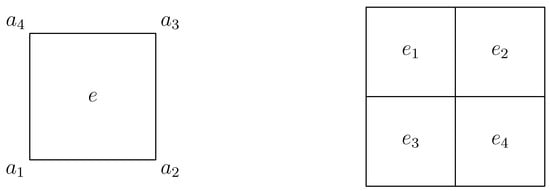
Figure 1.
The element (left) and (right).
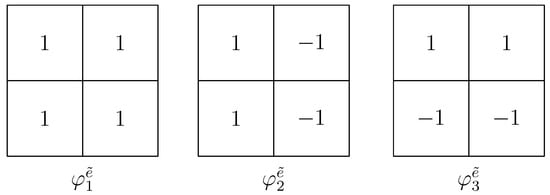
Figure 2.
Local basis functions of .
For the velocity, we use the Lagrange nodal interpolation operator as the corresponding interpolation operator. For the pressure, we first introduce the local -projection of p by
and then define the operator with respect to by
where with the notations of , . We can check that
which implies that for .
Lemma 1
([29]). Suppose that and , then there hold
Lemma 2.
Supposing that on element e, we have
Furthermore, there holds for
Proof.
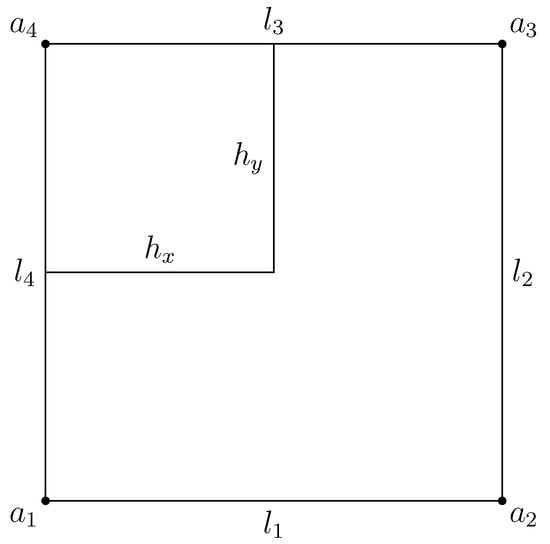
In order to obtain a second-order accuracy estimate, we adopt the high-accuracy integral technique developed in [32]. We introduce the following error function on an element e (see Figure 3):
where denotes the barycentric coordinate of element e. One can check that , . Note that v is constant on an element e, and we have
where we have that , and are constants in the above estimate.

Figure 3.
The element .
In the same way, we also have
We present the discrete Gronwall’s inequality, which is useful in the following error analysis.
Lemma 3
([33,34]). Let τ, B and , , , , for integers , be non-negative numbers such that
suppose that , for all k, and set . Then
The Young inequality will be frequently used in the following analysis, and we present it here.
The weak formulation of (1)–(4) is as follows: find , such that
Moreover, in order to give the fully discrete scheme, let be a given uniform partition of the time interval with time step and , . For a smooth function w defined on , denote
Then, the semi-implicit backward Euler low-order conforming mixed finite element scheme (bilinear-constant scheme) is as follows: for given , find such that
with the initial approximation .
The unconditionally optimal error estimate for scheme (18)–(19) is shown in [20] by using the error splitting technique with the low-order conforming mixed finite element method, specifically, by introducing the following time-discrete system [18,20]:
Then, the error between the exact solution and the numerical solution comprises two parts, where one is the temporal error and the other is the spatial error. Therefore, the numerical solution in the -norm can be bounded without any time-step restrictions. Here, we present a lemma to state the -independent boundedness of the numerical solution.
Lemma 4
([20]). Suppose that is the solution of (1)–(4) with suitable regularity and and are the solutions of (20)–(23) and (18)–(19). Then, there exist positive constants and such that when and , we have the τ-independent boundedness of numerical solutions
where K is a constant, which is not dependent on h, τ and n.
3. Superclose and Superconvergence Error Estimates
In this section, we firstly present the superclose error estimates for the velocity and pressure variables. Then, we give the superconvergence result in terms of the superclose error estimates as well as the interpolation technique.
Theorem 1.
Suppose that and are the solutions of (16)–(19) and , , and . Then, we have the following superclose estimates
Furthermore, we have the following optimal error estimates:
Proof.
For simplicity, we split the errors and as follows:
At , from (16)–(17), we have
Subtracting (18)–(19) from (27)–(28) gives the following error equations:
Alternatively, we have
Taking in (29) and in (31) yields that
Now, we start to estimate , term by term. By the Cauchy–Schwarz inequality and interpolation theory, we have
Applying the following equality
we have
where we used (8) of Lemma 1 in the above estimate.
With an application of (34) again, it follows that
where we used (9) of Lemma 1 in the above estimate.
According to (10) of Lemma 1, can be bounded by
To bound , we split as follows:
In terms of the Cauchy–Schwarz inequality and interpolation theory, we have
Using inverse inequality and interpolation theory, we have
With the aid of (35), one can check that
In order to obtain a high-accuracy error estimate, i.e., second-order accuracy, we introduce the local -projection defined as follows:
where e is an element of the partition of and is the measure of e. Then, we have
Therefore, we have
where we used Lemma 2 in the above estimate.
In the same way, we also have
Hence, there holds
By (24) of Lemma 4, the numerical solution is bounded unconditionally in -norm, and we have
Based on the above estimates , , reduces to
Moreover, by Taylor expansion, we have
With the estimates , , we obtain
On the other hand, from (29), it follows that
Then, one can check that by the Cauchy–Schwarz inequality and interpolation theory,
and
By Lemma 1, we have
Using a similar estimate process as , there holds
As an application of the Taylor expansion, we have
Therefore, we conclude that
Then, thanks to the discrete LBB condition ( is a positive constant independent of mesh-size h), we have
Substituting (58) into (50) and using the Young inequality, (50) reduces to
Choosing in (59) and summing up the resulting inequality, we have
where we used , Lemma 1 and the same estimate process (44) for .
Hence, from (60), there holds
Then, an application of the Gronwall lemma (see Lemma 3) yields
Putting (62) into (58) gives that
The desired results are obtained, and the proof is complete. □
With the aid of the superclose error estimate in Theorem 1, we adopt the interpolation post-processing approach to improve the accuracy of the numerical solution on the whole domain. Let be the piecewise biquadratic nodal interpolation operator for the velocity associated with . Moreover, for the pressure, the postprocessing operator is defined as
The following properties are shown in [29]:
Moreover, we also have from [29] that for ,
Now, we state the global superonvergence result in the following theorem:
Theorem 2.
Under the condition of Theorem 1, there holds
Proof.
By (64) and (65), we have
The proof is complete. □
4. Numerical Experiment
In this section, we present some numerical results to confirm the correctness of the theoretical analysis. The software we used is MATLAB 2018a with a 3.20 GHz Intel Core i5-6500 CPU processor and 8 GB memory.
Example 1.
Let , and divide into uniform rectangles. Moreover, the function and the initial and boundary conditions are chosen corresponding to the exact solution [35]:
We set the final time in the computation. In order to confirm the error estimates in Theorems 1 and 2, we present the numerical errors in Table 1, Table 2, Table 3, Table 4, Table 5 and Table 6 at , respectively. Obviously, it can be seen that the numerical results are in agreement with the theoretical analysis, i.e., the errors , , and for the velocity are of order , , and , respectively. In addition, the errors , and for the pressure p are of orders , and , respectively. At the same time, we also give the graphics of the exact solutions () and finite element solutions () at on mesh (see Figure 4, Figure 5, Figure 6 and Figure 7), respectively. It can be seen that the numerical results are also in good agreement with the theoretical analysis.

Table 1.
The numerical errors and convergence orders at of .

Table 2.
The numerical errors and convergence orders at of p.

Table 3.
The numerical errors and convergence orders at of .

Table 4.
The numerical errors and convergence orders at of p.

Table 5.
The numerical errors and convergence orders at of .

Table 6.
The numerical errors and convergence orders at of p.
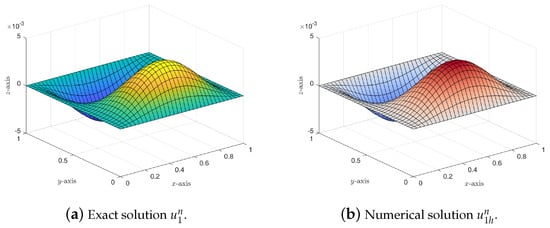
Figure 4.
The graphics of and on mesh .
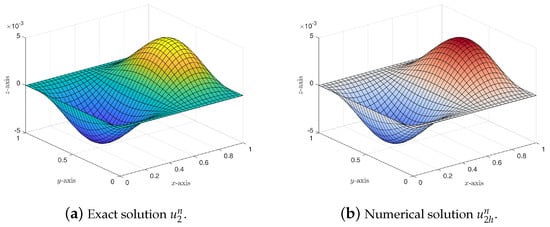
Figure 5.
The graphics of and on mesh .
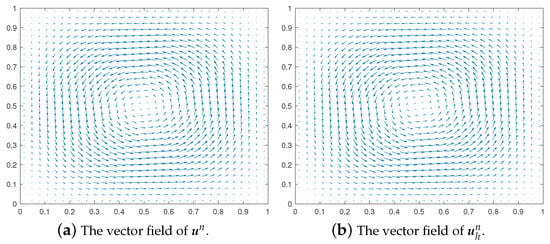
Figure 6.
The graphics of the vector fields on mesh .
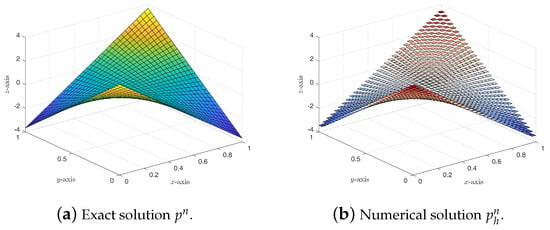
Figure 7.
The graphics of and on mesh .
Example 2.
Let and divide into uniform rectangles. Moreover, the function and the initial and boundary conditions are chosen corresponding to the exact solution [14]:
We set the final time in the computation. In order to confirm the error estimates in Theorems 1 and 2, we present the numerical errors in Table 7 and Table 8 at . Obviously, it can be seen that numerical results are in agreement with the theoretical analysis.

Table 7.
The numerical errors and convergence orders at of .

Table 8.
The numerical errors and convergence orders at of p.
5. Conclusions
In this paper, a low-order conforming mixed finite element method is investigated for time-dependent Navier–Stokes equations with the semi-implicit Euler scheme. With the help of the error splitting technique and the high-accuracy error estimates of the element pair on the rectangular mesh, the numerical solution in -norm is obtained without any time-step restrictions. Furthermore, the unconditionally superclose error estimates are derived by treating the trilinear term rigorously and skillfully. Moreover, the global superconvergence results are acquired in terms of the interpolation post-processing approach. It should be pointed out there are many interesting topics to study in future works, such as high-order time (e.g., Crank–Nicolson scheme and BDF2 scheme), low-order nonconforming mixed finite element methods, and fast computing for discretized linear system. We will study these topics in the future.
Author Contributions
X.M.; writing—original draft preparation; H.Y.; writing—review and editing, methodology, software. All authors have read and agreed to the published version of the manuscript.
Funding
H.Y. is supported by the National Natural Science Foundation of China (No. 12101568).
Data Availability Statement
The authors will supply the relevant data in response to reasonable requests.
Conflicts of Interest
The authors declare no conflict of interest.
References
- Girault, V.; Raviart, P.A. Finite Element Methods for Navier-Stokes Equations; Theory and Algorithms; Springer: Berlin/Heidelberg, Germany, 1986. [Google Scholar]
- Temam, R. Navier-Stokes Equations, Theory and Numerical Analysis; American Mathematical Society: North-Holland, The Netherlands; Amsterdam, The Netherlands; New York, NY, USA; Oxford, UK, 1984. [Google Scholar]
- Giraldo, F.X.; Restelli, M.; Laeuter, M. Semi-implicit formulations of the Navier-Stokes equations: Application to nonhydrostatic atmospheric modeling. SIAM J. Sci. Comput. 2010, 32, 3394–3425. [Google Scholar] [CrossRef]
- Strikwerda, J.C. Finite difference methods for the Stokes and Navier-Stokes equations. SIAM J. Sci. Stat. Comput. 1984, 50, 56–68. [Google Scholar] [CrossRef]
- Wang, C.; Liu, J.G. Analysis of finite difference schemes for unsteady Navier-Stokes equations in vorticity formulation. Numer. Math. 2002, 91, 543–576. [Google Scholar] [CrossRef]
- Li, Z.L.; Wang, C. A fast finite difference method for solving Navier-Stokes equations on irregular domains. Commun. Math. Sci. 2003, 1, 181–197. [Google Scholar] [CrossRef]
- Hou, T.Y.; Wetton, B.T.R. Convergence of a finite difference scheme for the Navier-Stokes equations using vorticity boundary conditions. SIAM J. Numer. Anal. 1992, 29, 615–639. [Google Scholar] [CrossRef]
- He, Y.N.; Li, K.T. Convergence and stability of finite element nonlinear Galerkin method for the Navier-Stokes equations. Numer. Math. 1998, 79, 77–106. [Google Scholar] [CrossRef]
- He, Y.N.; Sun, W. Sability and convergence of the Crank-Nicolson/Adams-Bashforth scheme for the time-dependent Navier-Stokes equations. SIAM J. Numer. Anal. 2007, 45, 837–869. [Google Scholar] [CrossRef]
- Li, J.; He, Y.N.; Chen, Z.X. A new stabilized finite element method for the transient Navier-Stokes equations. Comput. Methods Appl. Mech. Eng. 2007, 197, 22–35. [Google Scholar] [CrossRef]
- He, Y.N.; Li, J. A stabilized finite element method based on local polynomial pressure projection for the stationary Navier-Stokes equation. Appl. Numer. Math. 2008, 58, 1503–1514. [Google Scholar] [CrossRef]
- He, Y.N. A fully discrete stablized finite element method for the time-dependent Navier- Stokes problem. IMA J. Numer. Anal. 2003, 23, 665–691. [Google Scholar] [CrossRef]
- Suli, E. Convergence and nonlinear stability of the Lagrange-Galerkin method for the Navier-Stokes equations. Numer. Math. 1988, 53, 459–483. [Google Scholar] [CrossRef]
- Yang, H.J.; Shi, D.Y.; Liu, Q. Superconvergence analysis of low order nonconforming mixed finite element methods for time-dependent Navier-Stokes equations. J. Comput. Math. 2021, 39, 63–80. [Google Scholar] [CrossRef]
- Han, H.D. A finite element approximation of Navier-Stokes equations using nonconforming elements. J. Comput. Math. 1984, 2, 77–88. [Google Scholar]
- Xu, X.J. On the accuracy of nonconforming quadrilateral Q1 element approximation for the Navier-Stokes problem. SIAMJ. Numer. Anal. 2000, 38, 17–39. [Google Scholar] [CrossRef]
- Shi, D.Y.; Ren, J.C.; Hao, X.B. A new second order nonconforming mixed finite element scheme for the stationary Stokes and Navier-Stokes equations. Appl. Math. Comput. 2009, 207, 462–477. [Google Scholar] [CrossRef]
- Si, Z.Y.; Wang, J.L.; Sun, W.W. Unconditional stability and error estimates of modified characteristics FEMs for the Navier-Stokes equations. Numer. Math. 2016, 134, 139–161. [Google Scholar] [CrossRef]
- Li, M.H.; Shi, D.Y.; Li, Z.Z.; Chen, H.R. Two-level mixed finite element methods for the Navier-Stokes equations with damping. J. Math. Anal. Appl. 2019, 470, 292–307. [Google Scholar] [CrossRef]
- Yang, H.J.; Shi, D.Y. Unconditionally optimal error estimates of the bilinear-constant scheme for time-dependent Navier-Stokes equations. J. Comput. Math. 2022, 40, 127–146. [Google Scholar]
- Li, M.H.; Xiao, L.C.; Li, Z.Z. The supercloseness property of the Stoke projection for the transient Navier-Stokes equations and global superconvergence analysis. J. Appl. Math. Comput. 2023, 69, 2041–2057. [Google Scholar] [CrossRef]
- Shen, J. On error estimates of projection methods for Navier-Stokes equations: First-order schemes. SIAM J. Numer. Anal. 1992, 29, 57–77. [Google Scholar] [CrossRef]
- Shen, J. On error estimates of the projection, methods for the Navier-Stokes equations: Second-order schemes. Math. Comput. 1996, 65, 1039–1066. [Google Scholar] [CrossRef]
- Huang, P.Z.; Zhang, T.; Ma, X.L. Superconvergence by L2-projection for a stabilized finite volume method for the stationary Navier-Stokes equations. Comput. Math. Appl. 2011, 62, 4249–4257. [Google Scholar] [CrossRef]
- Huang, P.Z.; Feng, X.L. Error estimates for two-level penalty finite volume method for the stationary Navier-Stokes equations. Math. Methods Appl. Sci. 2013, 36, 1918–1928. [Google Scholar] [CrossRef]
- Liu, X.; Li, J.; Chen, Z.X. A weak Galerkin finite element method for the Navier–Stokes equations. J. Comput. Appl. Math. 2018, 333, 442–457. [Google Scholar] [CrossRef]
- Li, B.Y.; Sun, W.W. Error analysis of linearized semi-implicit Galerkin finite element methods for nonlinear parabolic equations. Int. J. Numer. Anal. Model. 2013, 10, 622–633. [Google Scholar]
- Li, B.Y.; Sun, W.W. Unconditional convergence and optimal error estimates of a Galerkin-mixed FEM for incompressible miscible flow in porous media. SIAM J. Numer. Anal. 2013, 51, 1959–1977. [Google Scholar] [CrossRef]
- Pan, J. Global superconvergence for the bilinear-constant scheme for the Stokes problem. SIAM J. Numer. Anal. 1997, 36, 2424–2430. [Google Scholar] [CrossRef]
- Liu, H.P.; Yan, N.N. Global superconvergence for optimal control problems governed by Stokes equations. Int. J. Numer. Anal. Model. 2006, 3, 283–302. [Google Scholar]
- Adams, R.A.; Fournier, J.J.F. Sobolev Spaces; Academic Press: Cambridge, MA, USA, 2003. [Google Scholar]
- Lin, Q.; Lin, J.F. Finite Element Methods: Accuracy and Improvement; Science Press: Beijing, China, 2006. [Google Scholar]
- Heywood, J.G.; Rannacher, R. Finite element approximation of the nonstationary Navier-Stokes problem IV: Error analysis of second-order time-discretization. SIAM J. Numer. Anal. 1990, 27, 353–384. [Google Scholar] [CrossRef]
- Gao, H.D. Optimal error analysis of Galerkin FEMs for nonlinear Joule heating equations. J. Sci. Comput. 2014, 58, 627–647. [Google Scholar] [CrossRef]
- Xu, C.; Shi, D.Y.; Liao, X. Low order nonconforming mixed finite element method for nonstationary incompressible Navier-Stokes equations. Appl. Math. Mech. Engl. Ed. 2016, 37, 1095–1112. [Google Scholar] [CrossRef]
Disclaimer/Publisher’s Note: The statements, opinions and data contained in all publications are solely those of the individual author(s) and contributor(s) and not of MDPI and/or the editor(s). MDPI and/or the editor(s) disclaim responsibility for any injury to people or property resulting from any ideas, methods, instructions or products referred to in the content. |
© 2023 by the authors. Licensee MDPI, Basel, Switzerland. This article is an open access article distributed under the terms and conditions of the Creative Commons Attribution (CC BY) license (https://creativecommons.org/licenses/by/4.0/).